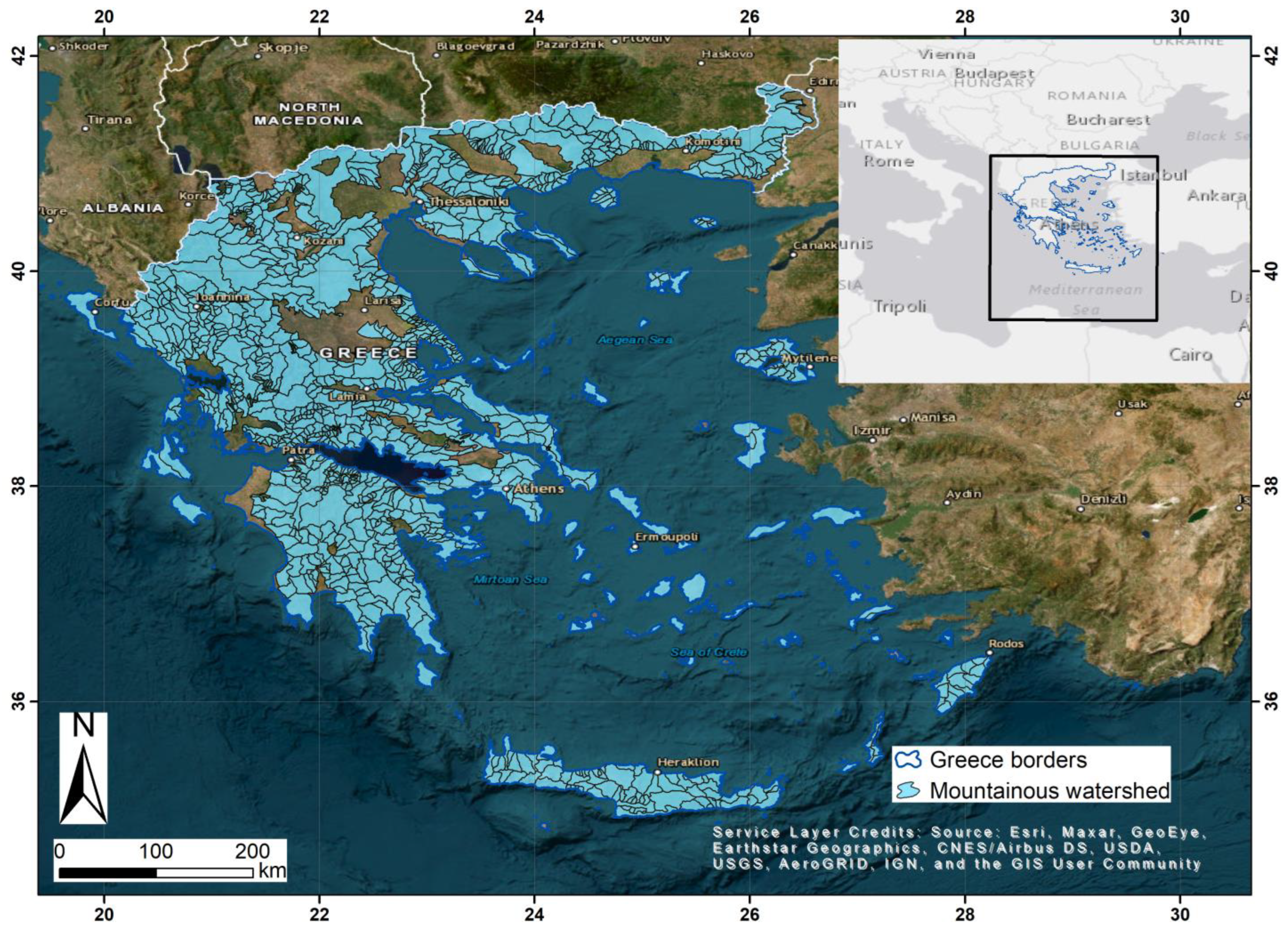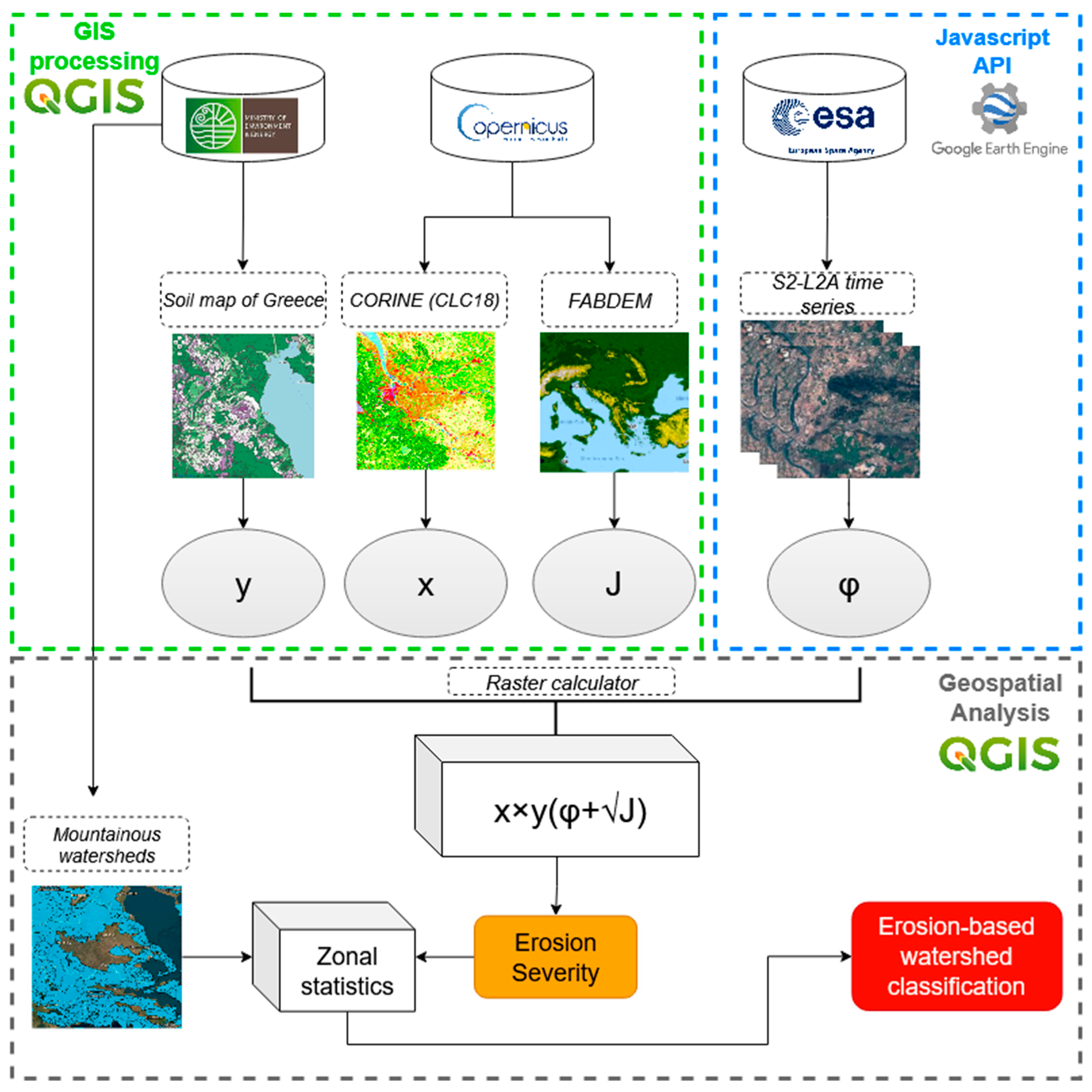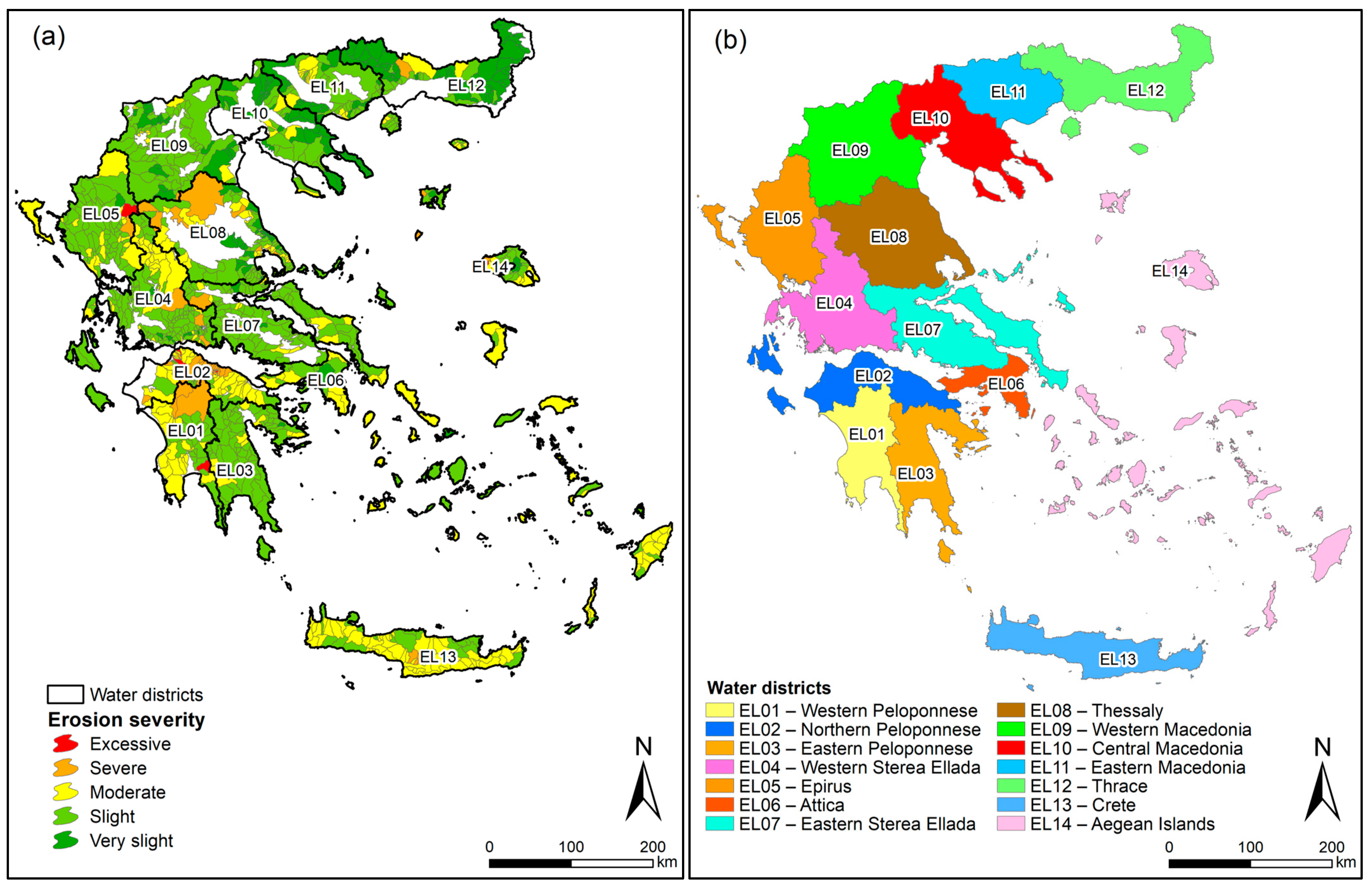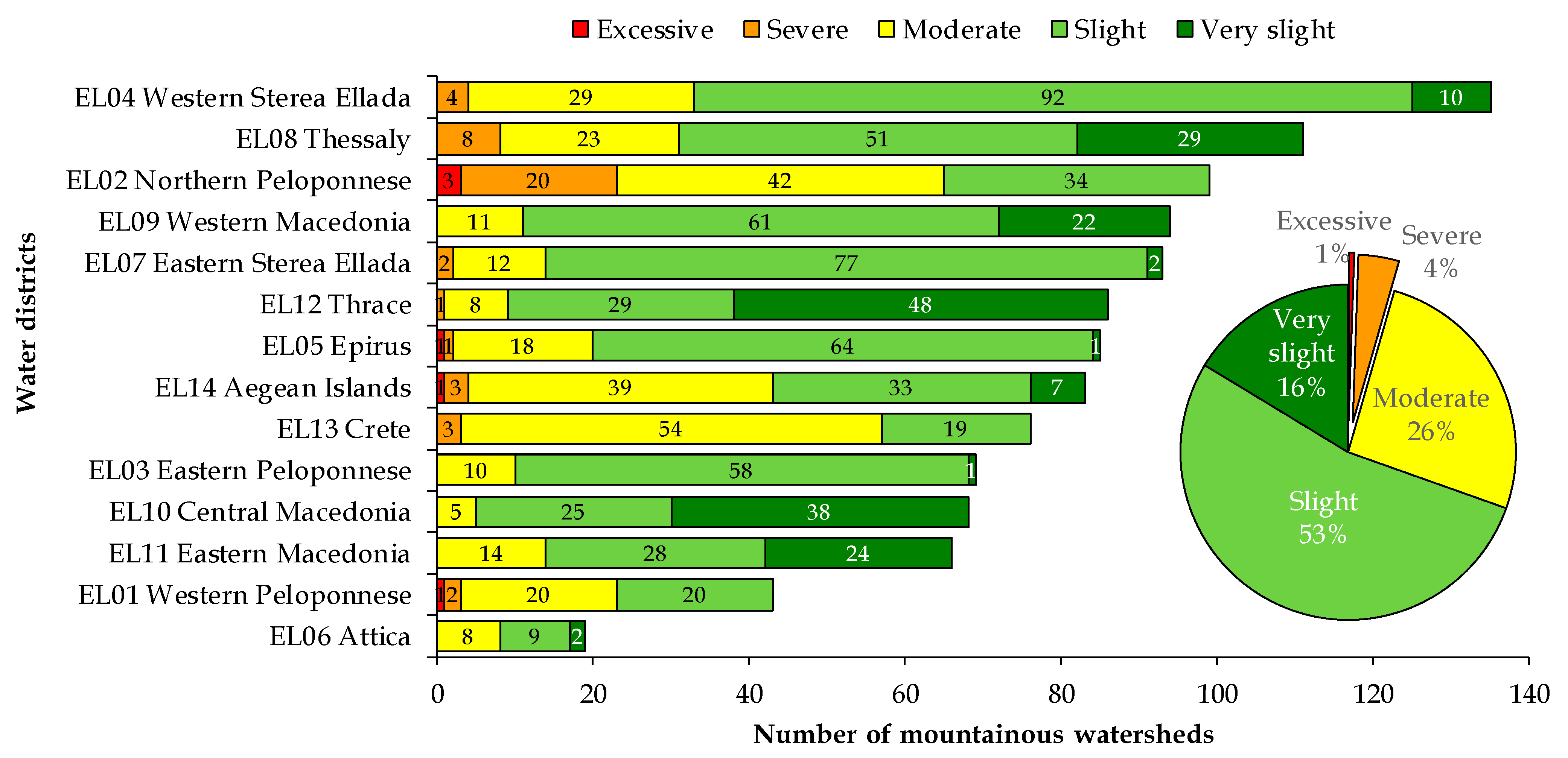Erosion-Based Classification of Mountainous Watersheds in Greece: A Geospatial Approach
Abstract
1. Introduction
2. Materials and Methods
2.1. Study Area
2.2. Datasets and Data Acquisition
2.3. EPM Erosion Coefficient
2.4. Methodology Workflow
3. Results
4. Discussion
5. Conclusions
Author Contributions
Funding
Institutional Review Board Statement
Informed Consent Statement
Data Availability Statement
Conflicts of Interest
References
- de Jong, C. Challenges for mountain hydrology in the third millennium. Front. Environ. Sci. 2015, 3, 38. [Google Scholar] [CrossRef]
- Kokkoris, I.P.; Drakou, E.G.; Maes, J.; Dimopoulos, P. Ecosystem services supply in protected mountains of Greece: Setting the baseline for conservation management. Int. J. Biodivers. Sci. Ecosyst. Serv. Manag. 2018, 14, 45–59. [Google Scholar] [CrossRef]
- Food and Agriculture Organization of the United Nations. Forests and Water: International Momentum and Action; FAO: Rome, Italy, 2013. [Google Scholar]
- Stefanidis, S.; Proutsos, N.; Alexandridis, V.; Mallinis, G. Ecosystem Services Supply from Peri-Urban Watersheds in Greece: Soil Conservation and Water Retention. Land 2024, 13, 765. [Google Scholar] [CrossRef]
- Yazdi, J.; Sabbaghian Moghaddam, M.; Saghafian, B. Optimal design of check dams in mountainous watersheds for flood mitigation. Water Resour. Manag. 2018, 32, 4793–4811. [Google Scholar] [CrossRef]
- Nones, M. Dealing with sediment transport in flood risk management. Acta Geophys. 2019, 67, 677–685. [Google Scholar] [CrossRef]
- Baggio, T.; Martini, M.; Bettella, F.; D’Agostino, V. Debris flow and debris flood hazard assessment in mountain catchments. Catena 2024, 245, 108338. [Google Scholar] [CrossRef]
- Myronidis, D.; Ioannou, K.; Sapountzis, M.; Fotakis, D. Development of a sustainable plan to combat erosion for an island of the Mediterranean region. Fresenius Environ. Bull. 2010, 19, 1694–1702. [Google Scholar]
- Myronidis, D.; Arabatzis, G. Evaluation of Greek post-fire erosion mitigation policy through spatial analysis. Pol. J. Environ. Stud. 2009, 18, 865–872. [Google Scholar]
- de Vente, J.; Poesen, J.; Verstraeten, G.; Govers, G.; Vanmaercke, M.; Van Rompaey, A.; Arabkhedri, M.; Boix-Fayos, C. Predicting soil erosion and sediment yield at regional scales: Where do we stand? Earth-Sci. Rev. 2013, 127, 16–29. [Google Scholar] [CrossRef]
- Igwe, P.U.; Onuigbo, A.A.; Chinedu, O.C.; Ezeaku, I.I.; Muoneke, M.M. Soil erosion: A review of models and applications. Int. J. Adv. Eng. Res. Sci. 2017, 4, 138–150. [Google Scholar] [CrossRef]
- Borrelli, P.; Alewell, C.; Alvarez, P.; Anache, J.A.A.; Baartman, J.; Ballabio, C.; Bezak, N.; Biddoccu, M.; Cerdà, A.; Chalise, D.; et al. Soil Erosion Modelling: A Global Review and Statistical Analysis. Sci. Total Environ. 2021, 780, 146494. [Google Scholar] [CrossRef] [PubMed]
- Andualem, T.G.; Hewa, G.A.; Myers, B.R.; Peters, S.; Boland, J. Erosion and sediment transport modeling: A systematic review. Land 2023, 12, 1396. [Google Scholar] [CrossRef]
- Wischmeier, W.H.; Smith, D.D. Predicting Rainfall Erosion Losses, a Guide to Conservation Planning; U.S. Department of Agriculture: Washington, DC, USA, 1978; Volume 537, p. 62. [Google Scholar]
- Renard, K.G.; Foster, G.R.; Weesies, G.A.; Porter, J.P. RUSLE: Revised universal soil loss equation. J. Soil Water Conserv. 1991, 46, 30–33. [Google Scholar] [CrossRef]
- Nearing, M.A.; Foster, G.R.; Lane, L.J.; Finkner, S.C. A process-based soil erosion model for USDA-Water Erosion Prediction Project technology. Trans. ASAE 1989, 32, 1587–1593. [Google Scholar] [CrossRef]
- Morgan, R.P.C.; Morgan, D.D.V.; Finney, H.J. A predictive model for the assessment of soil erosion risk. J. Agric. Eng. Res. 1984, 30, 245–253. [Google Scholar] [CrossRef]
- Williams, J.R.; Jones, C.A.; Dyke, P.T. A modeling approach to determining the relationship between erosion and soil productivity. Trans. ASAE 1984, 27, 129–144. [Google Scholar] [CrossRef]
- Kirkby, M.J.; Le Bissonais, Y.; Coulthard, T.J.; Daroussin, J.; McMahon, M.D. The development of land quality indicators for soil degradation by water erosion. Agric. Ecosyst. Environ. 2000, 81, 125–135. [Google Scholar] [CrossRef]
- Gavrilovič, S. Engineering of Debris Flow and Erosion; Izgradnja: Beograd, Serbia, 1972; p. 292. (In Serbian) [Google Scholar]
- De Vente, J.; Poesen, J. Predicting soil erosion and sediment yield at the basin scale: Scale issues and semi-quantitative models. Earth-Sci. Rev. 2005, 71, 95–125. [Google Scholar] [CrossRef]
- Karydas, C.G.; Panagos, P.; Gitas, I.Z. A classification of water erosion models according to their geospatial characteristics. Int. J. Digit. Earth 2014, 7, 229–250. [Google Scholar] [CrossRef]
- Gavrilovič, Z. Use of an Empirical Method Erosion Potential Method for Calculating Sediment Production and Transportation in Unstudied or Torrential Streams. In Proceedings of the International Conference on River Regime, Hydraulics Research Limited. Wallingford, Oxon, UK, 18–20 May 1988; pp. 411–422. [Google Scholar]
- Gavrilovič, Z.; Stefanovic, M.; Milovanovic, I.; Cotric, J.; Milojevic, M. Torrent classification-base of rational management of erosive regions. IOP Conf. Ser. Earth Environ. Sci. 2008, 4, 012039. [Google Scholar] [CrossRef]
- Bayat, R.; Gerami, Z.; Arabkhedri, M.; Peyrowan, H.R.; Kazemi, R. Investigating the Status of Some Indicators of Assessment of Watersheds and Prioritizing Sub-Catchments in Terms of Erosion Reduction (Case Study of Karkheh Watershed). J. Watershed Manag. Res. 2021, 12, 108–118. [Google Scholar] [CrossRef]
- Bezak, N.; Borrelli, P.; Mikoš, M.; Auflič, M.J.; Panagos, P. Towards multi-model soil erosion modelling: An evaluation of the erosion potential method (EPM) for global soil erosion assessments. Catena 2024, 234, 107596. [Google Scholar] [CrossRef]
- Sapountzis, M.; Myronidis, D.; Stathis, D.; Stefanidis, P. Comparison of the predicted erosion rates by USLE and Gavrilovič methods with field measurements. In Proceedings of the 1st Joint Conference EYE-EEDYP, Volos, Greece, 27–30 May 2009; pp. 155–165. (In Greek). [Google Scholar]
- Xanthakis, M. Soil Erosion Study in Mountainous Basins with Modern Technological Tools. Ph.D. Thesis, Harokopio University of Athens, Athens, Greece, 2011. (In Greek). [Google Scholar]
- Anastasiou, S. Determination of Degradation and Sediment Sources in Torrents’ Watersheds of Serres, Using GIS. Master’s Thesis, Aristotle University of Thessaloniki, Thessaloniki, Greece, 2013. (In Greek). [Google Scholar]
- Panagos, P.; Borrelli, P.; Poesen, J.; Ballabio, C.; Lugato, E.; Meusburger, K.; Montanarella, L.; Alewell, C. The new assessment of soil loss by water erosion in Europe. Environ. Sci. Policy 2015, 54, 438–447. [Google Scholar] [CrossRef]
- Nearing, M.A.; Xie, Y.; Liu, B.; Ye, Y. Natural and anthropogenic rates of soil erosion. Int. Soil Water Conserv. Res. 2017, 5, 77–84. [Google Scholar] [CrossRef]
- Hag Husein, H.; Al-Ahmad, M.; Ziadat, F.; Al Hafi, A.; Awawdeh, M.; Alkhaled, S.; Shakhatreh, Y. Soil erosion assessment in the rainy mountainous areas of the eastern Mediterranean: A case study of the El-Sarout watershed. Environ. Dev. Sustain. 2024. [Google Scholar] [CrossRef]
- Leite, J.; Ferreira, C.S.S.; Marques, J.; Castro, J.; Santos, J.L.; Nunes, J.P. The Application of Soil Erosion Models of an Agroforestry Basin under Mediterranean Conditions. Land 2024, 13, 1613. [Google Scholar] [CrossRef]
- Pimentel, D.; Harvey, C.; Resosudarmo, P.; Sinclair, K.; Kurz, D.; McNair, M.; Crist, S.; Shpritz, L.; Fitton, L.; Saffouri, R.; et al. Environmental and economic costs of soil erosion and conservation benefits. Science 1995, 267, 1117–1123. [Google Scholar] [CrossRef]
- Kosmas, C.; Danalites, N.G.; Cammeraat, L.H.; Chabart, M.; Diamantopoulos, J.; Farand, R.; Gutiérrez, L.; Jacob, A.; Marques, H.; Martínez-Fernández, J.; et al. The effect of land use on runoff and soil erosion rates under Mediterranean conditions. Catena 1997, 29, 45–59. [Google Scholar] [CrossRef]
- Borrelli, P.; Robinson, D.A.; Fleischer, L.R.; Lugato, E.; Ballabio, C.; Alewell, C.; Meusburger, K.; Modugno, S.; Schütt, B.; Ferro, V.; et al. An assessment of the global impact of 21st-century land use change on soil erosion. Nat. Commun. 2017, 8, 2013. [Google Scholar] [CrossRef] [PubMed]
- Li, Z.; Fang, H. Impacts of climate change on water erosion: A review. Earth-Sci. Rev. 2016, 163, 94–117. [Google Scholar] [CrossRef]
- Stefanidis, S.P.; Proutsos, N.D.; Solomou, A.D.; Michopoulos, P.; Bourletsikas, A.; Tigkas, D.; Spalevic, V.; Kader, S. Spatiotemporal Monitoring of Post-Fire Soil Erosion Rates Using Earth Observation (EO) Data and Cloud Computing. Nat. Hazards 2025, 121, 2873–2894. [Google Scholar] [CrossRef]
- El Jazouli, A.; Barakat, A.; Khellouk, R.; Rais, J.; Baghdadi, N.; Tribak, A. Integration of Remote Sensing and GIS Techniques for Soil Erosion Modeling in the Ourika Watershed, Morocco. Remote Sens. 2022, 14, 432. [Google Scholar]
- Pérez-Luque, A.J.; Zamora, R.; Castro, H.; Beltrán, G.; Herrera, J.P.; Benito, B.; Bonet, F.J. Soil Erosion in Mountainous Mediterranean Landscapes: Integrating Remote Sensing and GIS Techniques to Assess Soil Loss. Sustainability 2021, 13, 4821. [Google Scholar]
- Taghizadeh-Mehrjardi, R.; Minasny, B.; Sarmadian, F.; Malone, B.P.; Vafakhah, M.; Triantafilis, J. Digital Mapping of Soil Erosion Risk Using Machine Learning Algorithms in GIS and Remote Sensing. Land 2020, 9, 237. [Google Scholar]
- Stefanidis, P. Torrent Problem in Mediterranean Areas (Example from Greece). In Proceedings of the XX IUFRO World Congress—Technical Session on Natural Disasters in Mountainous Areas, Tampere, Finland, 6–12 August 1995; pp. 51–60. [Google Scholar]
- Kotoulas, D. Denudation and Sedimentation in Greece as an Example—From the Mountains and the Plain of Salonica. In Proceedings of the International Symposium of INTERPRAEVENT, Villach, Austria, 6–9 June 1984; pp. 343–353. [Google Scholar]
- Gorelick, N.; Hancher, M.; Dixon, M.; Ilyushchenko, S.; Thau, D.; Moore, R. Google Earth Engine: Planetary-Scale Geospatial Analysis for Everyone. Remote Sens. Environ. 2017, 202, 18–27. [Google Scholar] [CrossRef]
- Tamiminia, H.; Salehi, B.; Mahdianpari, M.; Quackenbush, L.; Adeli, S.; Brisco, B. Google Earth Engine for Geo-Big Data Applications: A Meta-Analysis and Systematic Review. ISPRS J. Photogramm. Remote Sens. 2020, 164, 152–170. [Google Scholar] [CrossRef]
- Ghosh, S.; Kumar, D.; Kumari, R. Cloud-Based Large-Scale Data Retrieval, Mapping, and Analysis for Land Monitoring Applications with Google Earth Engine (GEE). Environ. Chall. 2022, 9, 100605. [Google Scholar] [CrossRef]
- Nakos, G. Classification, Mapping and Assessment of Lands: Technical Instructions; Institute of Mediterranean Forest Ecosystems: Athens, Greece, 1991. (In Greek) [Google Scholar]
- Hawker, L.; Uhe, P.; Paulo, L.; Sosa, J.; Savage, J.; Sampson, C.; Neal, J. A 30 m global map of elevation with forests and buildings removed. Environ. Res. Lett. 2022, 17, 024016. [Google Scholar] [CrossRef]
- Meadows, M.; Jones, S.; Reinke, K. Vertical accuracy assessment of freely available global DEMs (FABDEM, Copernicus DEM, NASADEM, AW3D30 and SRTM) in flood-prone environments. Int. J. Digit. Earth 2024, 17, 2308734. [Google Scholar] [CrossRef]
- Marsh, C.B.; Harder, P.; Pomeroy, J.W. Validation of FABDEM, a Global Bare-Earth Elevation Model, Against UAV-Lidar Derived Elevation in a Complex Forested Mountain Catchment. Environ. Res. Commun. 2023, 5, 031009. [Google Scholar] [CrossRef]
- Stefanidis, S.; Stathis, D. Effect of Climate Change on Soil Erosion in a Mountainous Mediterranean Catchment (Central Pindus, Greece). Water 2018, 10, 1469. [Google Scholar] [CrossRef]
- Kostadinov, S.; Braunović, S.; Dragićević, S.; Zlatić, M.; Dragović, N.; Rakonjac, N. Effects of Erosion Control Works: Case Study—Grdelica Gorge, the South Morava River (Serbia). Water 2018, 10, 1094. [Google Scholar] [CrossRef]
- Globevnik, L.; Holjevic, D.; Petkovsek, G.; Rubinic, J. Applicability of the Gavrilović Method in Erosion Calculation Using Spatial Data Manipulation Techniques. Int. Assoc. Hydrol. Sci. Publ. 2003, 279, 224–233. [Google Scholar]
- Efthimiou, N.; Lykoudi, E.; Panagoulia, D.; Karavitis, C. Assessment of Soil Susceptibility to Erosion Using the EPM and RUSLE Models: The Case of Venetikos River Catchment. Glob. NEST J. 2016, 18, 164–179. [Google Scholar]
- Manojlović, S.; Sibinović, M.; Srejić, T.; Novković, I.; Milošević, M.V.; Gatarić, D.; Carević, I.; Batoćanin, N. Factors Controlling the Change of Soil Erosion Intensity in Mountain Watersheds in Serbia. Front. Environ. Sci. 2022, 10, 888901. [Google Scholar] [CrossRef]
- Stefanidis, P. Morphematischer und Hydrographischer Aufbau der Wildbachtypen im Nordgriechischen Raum. Wildbach-Und Lawinenverbau 1992, 121, 247–261. [Google Scholar]
- Xanthakis, M.; Pavlopoulos, K.; Kapsimalis, V.; Apostolopoulos, G.; Xanthopoulos, G.; Stefanidis, P.; Evelpidou, N. Prediction of Soil Loss in a Reservoir Watershed Using an Erosion Model and Modern Technological Tools: A Case Study of Marathon Lake, Attica in Greece. Environ. Sci. Proc. 2020, 2, 63. [Google Scholar]
- Petrović, A.M.; Manojlović, S.; Srejić, T.; Zlatanović, N. Insights into Land-Use and Demographical Changes: Runoff and Erosion Modifications in the Highlands of Serbia. Land 2024, 13, 1342. [Google Scholar] [CrossRef]
- Polovina, S.; Radić, B.; Ristić, R.; Milčanović, V. Application of Remote Sensing for Identifying Soil Erosion Processes on a Regional Scale: An Innovative Approach to Enhance the Erosion Potential Model. Remote Sens. 2024, 16, 2390. [Google Scholar] [CrossRef]
- Rikimaru, A.; Roy, P.S.; Miyatake, S. Tropical Forest Cover Density Mapping. Trop. Ecol. 2002, 43, 39–47. [Google Scholar]
- Karydas, C.G.; Panagos, P.; Gitas, I.Z. A classification framework for mapping soil erosion severity using Earth observation data. Geoderma 2022, 409, 115658. [Google Scholar]
- Ronchi, S.; Salata, S.; Arcidiacono, A.; Piroli, E.; Montanarella, L. Policy instruments for soil protection among the EU member states: A comparative analysis. Land Use Policy 2019, 82, 763–780. [Google Scholar] [CrossRef]
- Panagos, P.; Katsoyiannis, A. Soil erosion modelling: The new challenges as the result of policy developments in Europe. Environ. Res. 2019, 172, 470–474. [Google Scholar] [CrossRef] [PubMed]
- Panagos, P.; Lugato, E.; Ballabio, C.; Biavetti, I.; Montanarella, L.; Borrelli, P. Soil Erosion in Europe: From Policy Developments to Models, Indicators and New Research Challenges. In Global Degradation of Soil and Water Resources: Regional Assessment and Strategies; Lal, R., Stewart, B.A., Eds.; Springer Nature: Singapore, 2022; pp. 319–333. [Google Scholar]
- Carladous, S.; Piton, G.; Recking, A.; Tacnet, J.-M.; Liébault, F.; Kuss, D.; Quefféléan, Y.; Marco, O. Towards a better understanding of the today French torrents management policy through a historical perspective. E3S Web Conf. 2016, 7, 12011. [Google Scholar] [CrossRef]
- Lense, G.H.E.; Carvalho, D.F.; Cantalice, J.R.B.; da Silva, D.D.; Pruski, F.F.; Menezes, S.J.M.C. Soil Erosion Modeling with RUSLE in a Tropical Watershed: Evaluation, Limitations, and Application Perspectives. Water 2023, 15, 1490. [Google Scholar]






| Category | Erosion Severity | Erosion Coefficient Values |
|---|---|---|
| I | Excessive | Z > 1 |
| II | Severe | 0.71 < Z < 1 |
| III | Moderate | 0.41 < Z < 0.7 |
| IV | Slight | 0.2 < Z < 0.4 |
| V | Very slight | Z < 0.19 |
Disclaimer/Publisher’s Note: The statements, opinions and data contained in all publications are solely those of the individual author(s) and contributor(s) and not of MDPI and/or the editor(s). MDPI and/or the editor(s) disclaim responsibility for any injury to people or property resulting from any ideas, methods, instructions or products referred to in the content. |
© 2025 by the authors. Licensee MDPI, Basel, Switzerland. This article is an open access article distributed under the terms and conditions of the Creative Commons Attribution (CC BY) license (https://creativecommons.org/licenses/by/4.0/).
Share and Cite
Stefanidis, S.P.; Proutsos, N.D.; Tigkas, D.; Chatzichristaki, C. Erosion-Based Classification of Mountainous Watersheds in Greece: A Geospatial Approach. Sustainability 2025, 17, 8710. https://doi.org/10.3390/su17198710
Stefanidis SP, Proutsos ND, Tigkas D, Chatzichristaki C. Erosion-Based Classification of Mountainous Watersheds in Greece: A Geospatial Approach. Sustainability. 2025; 17(19):8710. https://doi.org/10.3390/su17198710
Chicago/Turabian StyleStefanidis, Stefanos P., Nikolaos D. Proutsos, Dimitris Tigkas, and Chrysoula Chatzichristaki. 2025. "Erosion-Based Classification of Mountainous Watersheds in Greece: A Geospatial Approach" Sustainability 17, no. 19: 8710. https://doi.org/10.3390/su17198710
APA StyleStefanidis, S. P., Proutsos, N. D., Tigkas, D., & Chatzichristaki, C. (2025). Erosion-Based Classification of Mountainous Watersheds in Greece: A Geospatial Approach. Sustainability, 17(19), 8710. https://doi.org/10.3390/su17198710









